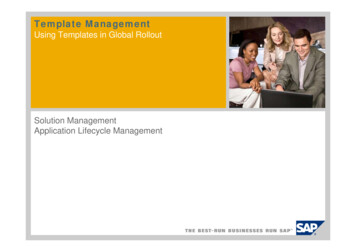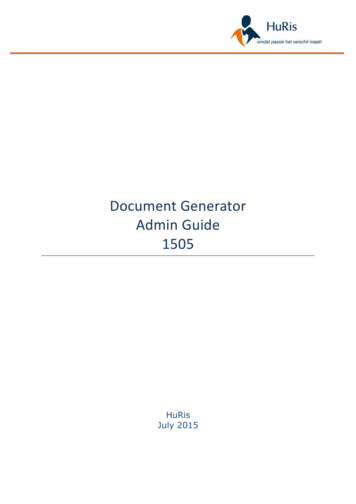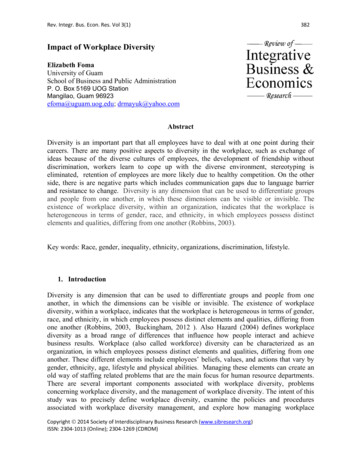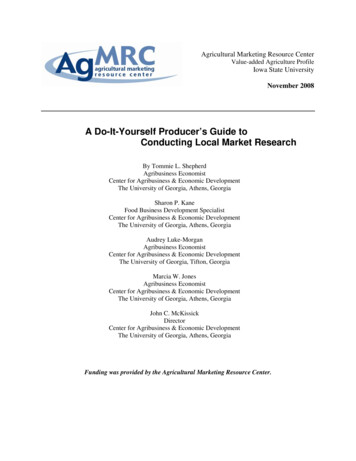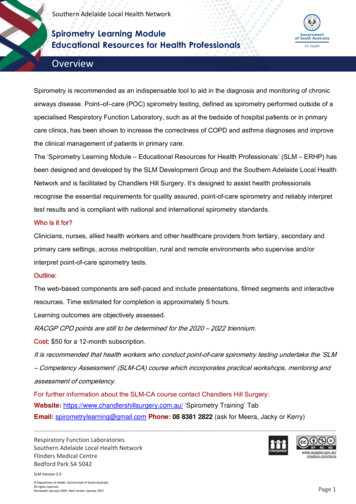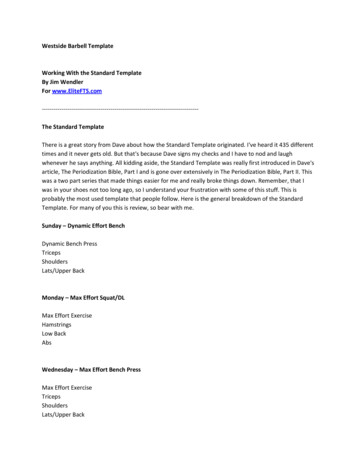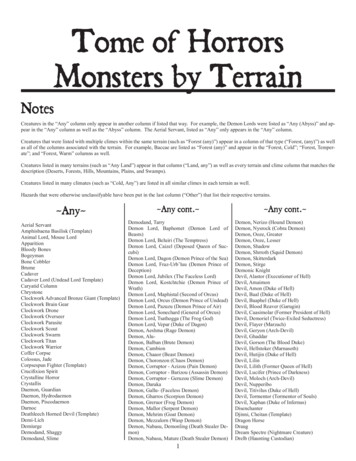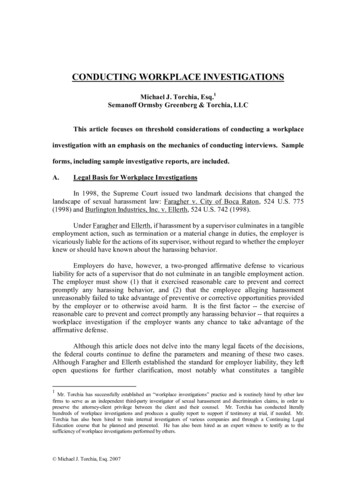
Transcription
CONDUCTING WORKPLACE INVESTIGATIONSMichael J. Torchia, Esq.1Semanoff Ormsby Greenberg & Torchia, LLCThis article focuses on threshold considerations of conducting a workplaceinvestigation with an emphasis on the mechanics of conducting interviews. Sampleforms, including sample investigative reports, are included.A.Legal Basis for Workplace InvestigationsIn 1998, the Supreme Court issued two landmark decisions that changed thelandscape of sexual harassment law: Faragher v. City of Boca Raton, 524 U.S. 775(1998) and Burlington Industries, Inc. v. Ellerth, 524 U.S. 742 (1998).Under Faragher and Ellerth, if harassment by a supervisor culminates in a tangibleemployment action, such as termination or a material change in duties, the employer isvicariously liable for the actions of its supervisor, without regard to whether the employerknew or should have known about the harassing behavior.Employers do have, however, a two-pronged affirmative defense to vicariousliability for acts of a supervisor that do not culminate in an tangible employment action.The employer must show (1) that it exercised reasonable care to prevent and correctpromptly any harassing behavior, and (2) that the employee alleging harassmentunreasonably failed to take advantage of preventive or corrective opportunities providedby the employer or to otherwise avoid harm. It is the first factor -- the exercise ofreasonable care to prevent and correct promptly any harassing behavior -- that requires aworkplace investigation if the employer wants any chance to take advantage of theaffirmative defense.Although this article does not delve into the many legal facets of the decisions,the federal courts continue to define the parameters and meaning of these two cases.Although Faragher and Ellerth established the standard for employer liability, they leftopen questions for further clarification, most notably what constitutes a tangible1Mr. Torchia has successfully established an “workplace investigations” practice and is routinely hired by other lawfirms to serve as an independent third-party investigator of sexual harassment and discrimination claims, in order topreserve the attorney-client privilege between the client and their counsel. Mr. Torchia has conducted literallyhundreds of workplace investigations and produces a quality report to support if testimony at trial, if needed. Mr.Torchia has also been hired to train internal investigators of various companies and through a Continuing LegalEducation course that he planned and presented. He has also been hired as an expert witness to testify as to thesufficiency of workplace investigations performed by others. Michael J. Torchia, Esq. 2007
employment action or a hostile work environment, and what are the parameters of theaffirmative defense.B.Introduction to Conducting the InvestigationInvestigations are conducted in myriad ways depending, of course, on factorssuch as the time allotted for the investigation, the number and types of witnessesinvolved, the nature of the claim, and the scope of the investigation itself. Aninvestigation of a shift supervisor in a meat packing plant in Tennessee will be vastlydifferent than an investigation involving a company President of a high-poweredadvertising firm in Boston.The conduct of the investigation will also depend highly on the Investigator –specifically, his or her personality, experience, personal style and skill and knowledge ofinvestigative techniques. A successful investigator is usually a “people person,” able toquickly assess a witness and establish rapport, and adjust to the varied emotions thatemerge during an interview. Many investigators are professional or semi-professionalinterviewers such as attorneys, human resources personnel, and former law enforcementofficers.The techniques for conducting an interview are as varied as the interviewersthemselves. Some investigators try to quickly establish a trust relationship, someempathize, and some cajole to evoke an anger response. Others will employ various triedand true investigative techniques such as feigning ignorance, feigning knowledge,repetition, and badgering. The best investigators, of course, will use a combination of allthese methods to obtain the most complete information from a given witness.There are many sources of information on the subject of investigation techniques.The following are a representative sample:Cynthia B. Schroeder, The Art and Science of ConductingInterviews and Investigations, (Pennsylvania Bar Institute 2002).Ragnar Benson, Ragnar’s Guide to Interviews, Investigations, andInterrogations: How to Conduct Them, How to Survive Them(Paladin Press 2002)William L. Fleisher & Nathan J. Gordon, Effective Interviewingand Interrogation Techniques (Academic Press, Inc. 2001)Amy Oppenheimer & Craig Pratt, Investigating WorkPlaceHarassment: How to Be Fair, Thorough and Legal (Society forHuman Resource Management 2002)2
Don Rabon, Interviewing and Interrogation (Carolina AcademicPress 1992)Stan B. Walters, Principles of Kinesic Interview and Interrogation(CRC Press 2d ed. 2002)David E. Zulawski & Douglas E. Wicklander, Practical Aspects ofInterview and Interrogation (CRC Press 2d ed. 2001)Paul J.J. Zwier & Anthony J. Bocchino, Fact Investigation: APractical Guide to Interviewing, Counseling and Case TheoryDevelopment (National Institute for Trial Advocacy 2000)David J. Lieberman, Ph.D., Never Be Lied To Again, (St. Martin’sGriffin 1998)See also Suzette Haden Elgin, The Gentle Art of Verbal SelfDefense, (Dorset Press 1980)C.Choosing the InvestigatorThere are many considerations when choosing an investigator: objectivity, impartialityexperience conducting investigationsfamiliarity with company and/or industryprofessionalismavailabilitycostability to effectively communicate in writing the finding of theinvestigationability to effectively communicate orally the finding of theinvestigation, i.e., will make a credible, likeable andunderstandable witnessCourts will determine the adequacy of the investigation, in part, based upon thecredentials of the investigator. See, e.g., Casiano v. AT&T Corp., 213 F.3d 278, 286(5th Cir. 2000) (court of appeals affirmed summary judgment for defendant employerwho suspended alleged harasser in part as a result of using two “E.O. Specialists” toconduct investigation); Smith v. First Union Nat’l Bank, 202 F.3d 234, 245 (4th Cir.2000) (court of appeals reversed summary judgment for defendant employer findinginadequate investigation where investigator had never before conducted a sexualharassment investigation, investigation focused on alleged harasser’s management stylerather than complaints of sexual harassment, and did not even mention the allegations ofsexual harassment to the alleged harasser); Cadena v. The Pacesetter Corp., 224 F.3d3
1203, 1209 (10th Cir. 2000) (employer’s investigation was “inadequate, if not a completeshame” where the investigator not only conceded that she did not speak with thecomplainant, alleged harasser or any other potential witnesses concerning the matter butalso admitted that she did not know the identities of complainant or the alleged harasserand was unsure if she had ever been told the nature of specifics of the complaint.)D.Mechanics of Conducting the Interview1.Preparing for the InterviewNo matter whether the investigator is in-house or hired from the outside, thoroughpreparation is needed prior to commencing the investigation. In-house or insideinvestigators are presumably familiar with the company, its work rules, organizationalstructure and disciplinary policies. Outside investigators will have to work harder tounderstand the company and how it functions. It is important to learn, as quickly and ascompletely as possible, everything about the personnel involved, the department, thegeneral mentality of the workforce, and the relationship between employees andmanagement. Attorney investigators should prepare for an investigation and interviewsas they would for discovery depositions.The investigator should outline areas of inquiry and list specific questions to beasked. A list of documents should be made and amended as new documents arediscovered or mentioned. In preparation for the investigation, the investigator shouldobtain and review the following documents, if they exist: company’s sexual harassment and related policiescompany’s disciplinary policiesalleged harasser’s personnel filealleged victim’s personnel fileprevious complaints made by alleged victim or against allegedharasserinternal correspondence regarding the complaintvideotape, audiotape, or voicemail regarding incidentsworn documents regarding the complaint, including papers filedwith the state administrative agency, or EEOC, and uniongrievancespreviously prepared statements of any witnesspreviously prepared notesemployment contracts of alleged harasser and victimcollective bargaining agreement4
2.LocationThe location of the interview is important. It should be conducted in a quiet,private room. Open offices or cubicles will not suffice. An office or small conferenceroom without windows (or windows with shades) usually suffices. Every effort shouldbe made to avoid interruptions by both the interviewer and interviewee.The interviews can be conducted on-site, that is, at the employer’s location, or ifthe employer believes the investigation will be too disruptive, distracting or there is nosuitable interview location, an off-site location can be used. Many investigators use thereown office facilities. Private rooms can also be easily reserved at many hotels and officesof court reporters.The interviewer should also plan ahead for the convenience of the witness. If theinterview is likely to go more than a few hours, the interviewer should, as appropriate,take a break or stop for lunch.3.Preliminary Statement and IntroductionKeep in mind that, in addition to the alleged harasser and harassee, manywitnesses will already know why they are being “called in” to speak with theinvestigator.When the witness first comes in, the investigator should introduce himself orherself and read the Preliminary Statement.My name is Mike Torchia and I would like to read thisstatement before we begin. This is my business card.I am an attorney, hired by ABC Company’sattorneys. I am here today to investigate claims of sexualharassment.Based on my preliminary investigation, itappears that you and your colleagues have importantinformation.I do not represent ABC Company, and I do notrepresent you. I am here as an independent investigator.I will also tell you that I have no relationship, personally orprofessionally to any ABC Company employee. This isthe first work of any kind I have performed for ABCCompany.5
I would like to ask you about the claims and wouldlike you to answer the questions honestly and completely.From your responses I will prepare an affidavit that youwill have an opportunity to correct. You will be asked tosign your affidavit.You should know that the information you provide isnot confidential. Although I and the Company will makeevery attempt to keep the information confidential, asshould you, Company executives and their attorneys willhave access to the information and your statement willbecome part of the investigative file and my final report.At the conclusion of this interview, please do notdiscuss your statements or my questions with anyoneexcept your attorney.There are a variety of initial standard questions that should be asked ofthe witness. It is essential to know: Full name and “nicknames” Job title, duties and shift worked for the relevant time period Start and end dates with employer Family members, significant others, etc. who work at thesame company Supervisors’ names and titles Supervisees’ names and titles Whether the witness has previously been involved in aninvestigation or serious disciplinary procedure at thecompany What the witness has been told by others alreadyinterviewed What the witness has been told by others involved in thematter6
What the witness has been told by supervisors ormanagement Whether the witness is tape recording the interview (theinvestigator should confirm the interview is not being,and cannot be recorded) Whether the witness has been given or offered anything ofvalue to provide or withhold certain testimony Whether the witness has been threatened in any way toprovide or withhold certain testimony4.To Record or Not to Record?It is often debated whether an investigative interview should be audio orvideotaped. Some suggest having a court reporter present at the interview to take a swornstatement. While these recording techniques have their place in litigation, generally,recording an investigative interview is disfavored.Most witnesses feel uncomfortable being recorded, and will not be as forthcomingwith information. They will be much less likely to implicate themselves, or explain theextent to which they witnessed an event. In short, most interviews proceed better whenthey are “off the record.” Of course, there is no such thing as “off the record” in theinvestigative context, but witnesses have the illusion of confidentiality and informalitywhen the investigator is “only” taking handwritten notes.Tape recording also creates a cumbersome, yet discoverable record, but withoutthe body language and physical inflection of the communication. These tape recordingsinevitably lead to transcripts which can make the entire investigative process expensiveand ponderous.If you decide to record, check state law regarding consent of tape recordings.Even if the witness initially consents to being recorded, it is advisable to take steps toavoid a claim under a state or federal law prohibiting such recording. See Wiretappingand Electronic Surveillance Control Act, 18 Pa. Cons. Stat. Ann. §§ 5701-5781 (West2007). Keep the recorder in plain view at all times. Make certain you state, with therecorder running, the date, time and place of the interview, and the name of theinterviewer and witness. Make sure the witness consents on tape to the recording.Acknowledge the recording at least once an hour, getting the witness to continue toconsent. At the end of the interview, once again have the witness confirm that the entireinterview was tape recorded and consent was given. The investigator should be thecustodian of the original tapes and they must be accurately labeled with the “tabs”popped out to avoid inadvertently recording over the interview.7
Lie detector tests are sometimes viewed by clients as the perfect solution whenfaced with a difficult credibility determination. Except in limited circumstances, it is aviolation of federal law and many states’ laws for an employer to force an employee totake a lie detector test. See The Employee Polygraph Protection Act, 29 U.S.C.A. §§2001-2009 (West 2007).5.Representatives at the InterviewAs a matter of law, certain employees have the right to have a representative oftheir choosing present during an investigatory interview, as long as the interview will notbe delayed. These rights are commonly referred to as Weingarten rights, after theseminal case that determined union employees have the right to a union representative atan investigatory interview. See National Labor Relations Bd. v. J. Weingarten, Inc., 420U.S. 251 (1975). The right to have a representative present has been extended to nonunion employees. See Epilepsy Foundation of North East Ohio v. NLRB, 268 F.3d 1095(D.C. Cir. 2001), cert. denied, 536 U.S. 904 (2002); see also Commonwealth ofPennsylvania Office of Administration v. Pennsylvania Labor Relations Bd., No. Civ.A.101MAP2005, 2007 WL 519167 (February 20, 2007) (in Pennsylvania, Public EmployeeRelations Act grants Weingarten rights to individual employees). In Pennsylvania, a“representative” does not include a private attorney. See Cheltenham Twp. v.Pennsylvania Labor Relations Bd., 846 A.2d 173 (Pa. Commw. 2004)2Without getting into extensive debates about who can or cannot be present andunder what circumstances, for the investigator, the question is often one of practicality,not law. For example, if the complainant insists on having her attorney present at theinterview, and the investigator does not want anyone present, there are only threechoices: (1) try and convince the complainant to be interviewed without therepresentative present (which more often than not fails); (2) interview with therepresentative; or (3) cancel the interview. Normally, it is more important to conduct theinterview rather than cancel it, especially if the interview is of a complainant, harasser ormaterial witness.Sometimes, the employer will “remind” the employee that she must participate inthe investigation, and may even threaten disciplinary action or termination for noncompliance. Although the employer may well be within its rights to do so, this iscounterproductive to resolving the underlying complaint and may very well lead to anadditional charge of retaliation.With come pre-interview discussion about the ground rules for the interview, i.e.,the representative should merely observe when at all possible, most problems can beavoided.8
6.Order of InterviewsIt is important to determine the order of the interviews to be conducted. Manytimes the order is pre-determined by witness’ availability which are affected by a varietyof conflicts such as business trips, vacations, personal commitments, medical proceduresand the like.The complainant should be interviewed first. It is difficult and inefficient tointerview others, including the alleged harasser(s), while being forced to guess or assumewhat the complainant would say. There are, however, circumstances when thecomplainant may not be the first interview: Complainant is unavailable Complainant refuses to be interviewed, or interviewed first There are cross-complaints with no clear “primary” complainant Material witness or alleged harasser will shortly becomeunavailable and the investigator feels it necessary to “lock-in” thetestimony Concern that material witness or alleged harasser will bethreatened, influenced to change statement, or will independentlydiscovery facts tending to change his or her statement, and theinvestigator feels it necessary to “lock-in” the testimony Alleged harasser is influential in the company and insists on beinginterviewed firstNormally, the sequence of interviews is:Complainant Harasser Witnesses ComplainantRe-interviewing the complainant is almost always necessary, as the harasser, atleast, raises issues and new facts. Of course, it may be necessary to re-interview theharasser or witnesses if additional information is discovered which requires clarification,confirmation or rebuttal.7.2Interviewing the ComplainantBeware, state laws differ, for example California and Rhode Island allow an attorney to be present.9
Interviewing the Complainant is the main event of every sexual harassmentinvestigation. The interviewer should plan to spend several hours with the Complainant,even for the simplest of complaints.Complainants will be presented with the same Preliminary Statement as the otherwitnesses, which should reassure them that the investigator is objective. TheComplainant should also be told that the company has responded to her complaints andintends to conduct a prompt and thorough investigation.3The Complainant should be reassured that, to the extent possible, the investigationwill be kept confidential, although several others will know the substance of herstatements.It is better to begin asking general, open-ended questions.Be sure to ask all the “W questions” – who, what, when, where, and why.In addition to the general witness questions, every Complainant must be asked thefollowing: witnesses to incident(s) documents or physical evidence to support her version of the facts whether harasser has taken the same action against others whether the complaint was reported to anyone, and if not, why not prior problems with harasser prior relationship with harasser prior complaints of sexual harassment (whether or not at the samecompany)Although it would seem that complainants would relish the opportunity to telltheir story against an alleged harasser, there are myriad reasons why complainants can bereluctant to testify. Many complainants are concerned about retaliation, being disciplinedor losing their jobs, despite assurances to the contrary. Often complainants, even thoughthey presumably made the complaint to make the harasser stop his conduct, “don’t wantto get him in trouble” and express genuine concern for what action the company may takeagainst him. Complainants may also fear physical retaliation or abuse from the harasser,or being outcast by co-workers sympathetic to the harasser. Complainants represented bycounsel are more likely not to fear retaliation and are generally more at ease attacking theharasser.If the Complainant is totally uncooperative, the investigation should nonethelesscontinue, and the investigator should gather as much information as possible fromwitnesses and other sources. In this case, “hearsay” becomes more important, i.e., what3Although men or women can make complaints of sexual harassment, the paradigm remains a maleharasser and female victim. With the apologies to all harassed males, we will refer to the victim as awoman.10
the complainant told others about the complaint. The investigative report should reflectthe fact the complainant was uncooperative, citing her reasons if known.8.Interviewing the Alleged Harassera.Initial Statements to the HarasserAn alleged harasser is unlikely to say much of anything if he feels the investigatoris biased or the outcome is predetermined. The alleged harasser must be assured theinvestigator is objective, no judgment or decisions have yet been made, and (if true), theinvestigator is merely reporting facts and will not make any recommendations to thedecision makers.The harasser should be reassured, to the extent possible, the investigation will bekept confidential, although several others will know the substance of his statements.The harasser needs to know there have been complaints brought against him, andthe company is quickly conducting an investigation to discover facts.As an interview technique, the identity of the victim can be kept from the harasseruntil certain open-ended questions are asked. As a practical matter, alleged harassers arevery hesitant, to say the least, to rebut any allegations if the complainant is not identified.Harassers should be confronted with each and every allegation against them, andin fairness, every defense explored, including whether any documents or physicalevidence exists, and whether there are witnesses they believe support their version of thefacts. Although tempting to do so, the investigator should not assume the harasser’sanswers. Assumption is the enemy of logic. The investigator must also not suggestanswers before hearing the harasser’s version of the facts. For example, the investigatorshould not say the following:DO NOT ASK:Q: Did you grab her leg or just happen to bump into her?Q: Did you call her a “bitch” out of anger or were you just kidding?Q: Did you just walk up and start massaging her shoulders or did shemotion for you to come over?Tell the harasser that retaliation against the victim or any witness will not betolerated and will be reported in the Investigative Report.11
Plan to spend significant time interviewing the harasser.complainant herself, this will take the most time.b.Except for theStereotypical HarassersChances are, you will know how the alleged harasser is approaching theinvestigation within the first few minutes of the interview. People who regularly conductinvestigations or interviews begin to see distinct categories of reactions by someonebeing questioned or investigated. Although stereotypes are, by definition, generalities, anexamination of several common approaches is instructive. Many harassers float in andout of the stereotypes during the investigation, some during the same interview.Cooperative: The cooperative harasser will answer all questions andvolunteer information. Usually a cooperative harasser will overcompensate andvolunteer more information than you need or ask for. Cooperation can be genuine orfeigned. Cooperative harassers are often overly apologetic and say things such as “I’dnever do anything to hurt her,” “I’ll take a lie detector if you want,” “I just want toapologize and make things right.” If the cooperative harasser is evasive, the investigator’s contrarytechnique is to be forceful, neutralizing the harasser’s friendly approach and letting himknow this is a serious affair.Practical: The practical harasser comes across as a no-nonsense type.Mid-level supervisors often fall into this category. They are guarded, will provideinformation but do not volunteer, seem concerned but detached at times, and will focuson the logistics of the investigation asking questions such as “What happens now?” “DoI get to see the report?” “Are you making a recommendation?” and similar questions.Interviews with practical harassers tend to be short because of their disinclination tovolunteer information. The investigator’s contrary technique is to repeat the same question untilanswered or use flattery to develop rapport.Silent type: The silent type harasser is usually angry. It’s theinvestigator’s job to discovery what he is angry about. He may be angry because theallegations are false, or because they are true and he has been caught. He may be angrybecause he thinks he should be angry, and you will be more likely to believe him. Silenttype harassers say almost nothing, and answer questions in few words. Many times theyhave been advised to answer questions in that manner from an attorney or unionrepresentative.12
The investigator’s contrary technique is to stay friendly, and reassure theharasser you are objective and the process is not predisposed to finding him responsible.Hostile: Like the silent type, the hostile harasser is angry, but lashes outat the investigator, the victim, and usually anyone else mentioned during the interview.The hostile harasser is likely to defend himself with extraneous facts and arguments.Since emotions run high in harasser interviews, an alleged harasser can start the interviewperfectly calm and become a hostile harasser when the investigator begins to ask probingquestions. The investigator’s contrary technique is to stay calm and friendly, usinghumor to the extent possible. If the hostile harasser doesn’t walk out of the room in thefirst ten minutes, he is likely to calm down and provide information.Distracter: A distracting harasser will evade the questions and provideextraneous and irrelevant information to distract the investigator from the fact that he isnot answering the question. Any good investigator will sift through the muck and obtainan answer, or simply ask the question again. Some distracters are very good, however, atmaking it appear as if they answer the question. This is especially true for upper levelmanagement and executives, who are adroit at deflecting difficult inquiries.Consider the following exchange from an actual interview with a distracterharasser who was a rank and file factory worker:Q:A:Q:A:Q:A:Q:A:As you know, I interviewed [Complainant] yesterday.She said you called her all sorts of names. Let’s startwith this. When you came into the lunchroom lastThursday, did you call [Complainant] a “skank”?Jimmy G, he’s the guy I told you about in packaging,knows [Complainant] since he’s a kid and says herwhole family is trash.Let’s focus on what you said in the lunchroom. Didyou call [Complainant] a “skank”?Here’s the thing. There’s like, a hundred people inthat lunchroom everyday. Everybody is sayingeverything.Okay, but did you call her a “skank” last Thursday?I’m dead either way, right? If I say no, she’s justgonna say yes, and I’m dead, because she works upthere in the office.No one is making any decisions here. Did you say. . . . . that whole family. . .13
Q:A:Q:A:. . .that to her? Did you?[hesitating] Yeah, but it’s true.What’s true? What’s a “skank”?You know. Skank. She’s skanky. The investigator’s contrary technique is to focus the questions until thedistracter answers, no matter how many times he attempts to distract.Questioner: The questioning harasser will answer questions withquestions. He will attempt to avoid answering questions until he feels he knows “whereyou are going” with the inquiry. Some will outright refuse to answer questions until youanswer their questions. The investigator’s contrary technique is to become forceful and insist; oremploy the distracter technique and answer his question with minimal or non-responsiveinformation.Educated:Some harassers believe they are, or actually are, educatedto the process of the investigation. This occurs when investigating, for example, anattorney, human resources manager or upper level manager. The educated harasser willtry to shortcut your questions by getting to what he thinks you are asking. For example:Q:A:Have you completed an evaluation on theComplainant since she made theseallegations against you?I didn’t do anything to retaliate against her ifthat’s what you mean.orQ:A:Did you ever ask her about her sex life?(rolls his eyes) No, there’s no way she cansay she worked in a hostile workenvironment.Educated harassers can be difficult to interview, especially if they are, in fact,educated to the process. The investigator’s contrary technique is to keep the educated harasseroff guard. Instead of asking about one incident, completing the inquiry and moving on,get the information in bits and pieces. This will help distract the educated harasser fromseeing a pattern in the questioning and making assumptions about the reasons for yourquestions.14
9.Concluding the InvestigationAfter making certain that all pertinent
David J. Lieberman, Ph.D., Never Be Lied To Again, (St. Martin's Griffin 1998) See also Suzette Haden Elgin, The Gentle Art of Verbal Self Defense, (Dorset Press 1980) C. Choosing the Investigator There are many considerations when choosing an investigator: objectivity, impartiality experience conducting investigations

